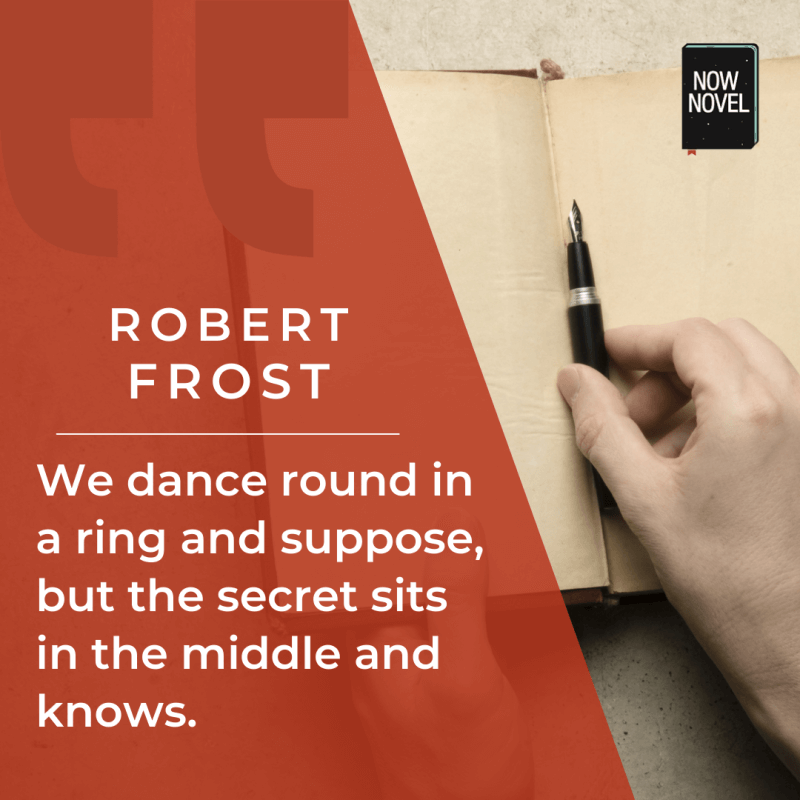Writing the middle of a novel has its own unique challenges. You need to develop your story further after your engrossing start and set in place the build to the end. The curse of the ‘saggy middle’ can’t take hold. Read 9 tips on how to write the middle of a story and get it right:
How to write the middle of your novel: 9 tips
- Change locations for new developments and challenges
- Raise uncertainty about character goals and outcomes
- Increase plot complications and obstacles
- Create subplots that add interest to main arcs
- Introduce interesting minor characters
- Stay focused on eventual character goals
- Build to a lesser peak
- Shorten the middle to move swiftly to resolution
- Take notes on the best middle chapters
Let’s examine these ideas for writing the middle of a book closer:
1: Change locations for new developments and challenges
The 5 w’s of story – where, what, why, who and when – may all change to create variety and interest.
None of these elements must change. The characters in your novel or your setting could remain fairly constant. Yet change opens up possibilities for new developments and intriguing new scenarios. These keep your novel exciting and interesting.
There are many examples from literature of changes in location that help to create interesting story middles.
In Charles Dickens’ classic coming-of-age novel Great Expectations, the protagonist Pip moves from his home village in Kent to the larger London, upon receiving wealth from a mystery benefactor.
This change of location underscores Pip’s increase in status, a facet of his character arc. It also introduces interesting new settings and characters, as Dickens moves from describing village to city life.
In David Mitchell’s Cloud Atlas, each section of the book changes location, from the Chatham Islands just off New Zealand to a futuristic imaginary state in Korea.
The central section of the book, however, is set in a post-apocalyptic society. The setting of this section is gradually revealed, as we piece together clues from narration and dialogue about its history.
Through the change in both aspects of setting – time and place – Mitchell adds mystery. The middle considerably expands the many unknowns of the story wanting resolution.
To avoid your story stagnating in a single location, try shifting somewhere new – another town or country, from the city to the countryside or vice versa.
Make sure any change of setting makes sense in relation to the preceding plot, and connects to your characters’ core goals and desires.
2: Raise uncertainty about character goals and outcomes
In the first third of your novel, you introduce pivotal characters and their goals.
For example, in Tokien’s The Fellowship of the Ring, we learn quickly that the hero Frodo must go on a quest. He’s tasked with taking an inherited artifact, the powerful One Ring, away from his homeland, The Shire.
Yet towards the middle of the book, tension mounts. Frodo faces the primary antagonist’s henchmen, treacherous terrain, and more.
Use the middle to increase uncertainty about characters’ outcomes. This advice applies for diverse genres. In a romance, the middle is often where two characters pull (or are driven) apart, for example. In well-structured stories, middles are all about tension and release, progress and setbacks.
In Jane Austen’s Pride and Prejudice, for example, the protagonist Elizabeth Bennett visits her friend Charlotte in Kent around the middle of the story. Lizzie is invited to the home of Lady Catherine de Bourgh, who is incidentally also the aunt of her eventual love interest, Mr Darcy. There are misunderstandings between Elizabeth and Darcy, who proposes to her with unfortunate timing (and emphasizes her lower rank more than his actual desire to marry her!)
As Austen does, use the middle of your novel to make an increasingly plausible outcome – whether a marriage or hero/villain showdown – encounter new complications.
How do you raise uncertainty? By increasing obstacles:
3: Increase plot complications and obstacles
When writing the middle part of a story, use a turn of events or sudden setback to add dramatic tension and suspense.
Readers become less certain characters will get the outcomes their opening chapters suggest.
Possible complications in the middle of a book include:
- Misunderstandings between characters
- Unexpected physical obstacles (e.g. in a quest fantasy, finding a planned route impassable)
- Discoveries that change characters’ understandings or goals (for example, Elizabeth’s gradual realisation that Darcy is a finer person than she thought in Pride and Prejudice)
The ‘sagging middle syndrome’ in the middle of a book is often caused by insufficient development towards a climax. As we read, we get a visceral sense of the author wondering, ‘OK, what next?’
Obstacles and complications do some of this building by showing the twists and kinks in the path from A to B, in narrative cause and effect.
Subplots also help to make the middle of a story more interesting:
4: Create subplots that add interest to your main story arc
Why are subplots useful for making your main story arc more interesting, especially in the middle of a book?
A good subplot in the middle of a story may:
- Give characters the knowledge or skill they need to achieve an aim
- Introduce supplementary information that adds urgency (e.g. a new side character who reveals an antagonist’s secondary goal that heightens the need to take them down)
- Provide ways to add more variety to your rising and falling action so far
In J.K. Rowling’s Harry Potter series, for example, there are plenty of subplots within each novel.
In Harry Potter and the Chamber of Secrets, the main arc involves Harry confronting what lies in the secret chamber of the title. In a subplot towards the middle of the novel, Harry and his friends venture into the Forbidden Forest that surrounds their magic school. They do this to understand why spiders are fleeing the school for the forest, following a series of deadly attacks on the school grounds.
What seems like sideways action away from the main location of the story’s core mystery (the main school building) turns out to be valuable, providing the friends more information about the foe they will face in the end.
Like Rowling’s subplots, the middle subplots in your novel should give characters what they need to progress further towards their goals. Harry and his friends can only stop the mysterious attacks by following another lead first.
Initially the subplot – an arachnid exodus – seems unrelated to the main story arc. Yet it is woven back into the main story, so that multiple narrative uncertainties combine and spill into one another.

Improve with constructive feedback
Join Now Novel’s groups to trade feedback with peers for free, or subscribe
to work one on one with your own dedicated writing coach.
5: Introduce interesting minor characters
Writing the middle is an opportunity to expand your cast of characters, breathing new life into your story.
In Fyodor Dostoevsky’s Crime and Punishment, the protagonist’s mother and sister arrive in his city to meet the sister’s fiancé. The timing of the visit is abysmal, since the protagonist Rodion has only recently committed a terrible crime.
This character introduction produces high tension and suspense. There is narrative irony (where the reader knows more than some characters do) due to Rodion’s family’s ignorance of his terrible deed.
The reader wonders whether Rodion will crack under the pressure of having to engage with his close family members under intense circumstances.
New characters can thus introduce additional suspense and tension. Minor characters can also possess knowledge or skills essential to your characters’ progress towards their goals, as the leader of the spiders does for Harry and his friends in the previous example.
Bringing in new characters in the middle of your book will enable new dynamics and possible conflicts and tensions between characters.
6: Stay focused on eventual character goals
One cause for a mushy middle in a novel is the sense of direction and purpose disappearing. Scenes need purpose.
Often beginning authors will add scenes to the middle that show relationships between characters but don’t suggest how these relationships are relevant to broader story arcs.
The crucial task in the middle of your novel is to connect.
If your main character heads out to see friends and they engage in fun dialogue and banter, try to relate at least some of this dialogue to approaching scenes and developments in your story.
7: Build to a lesser peak
A ‘false’ climax in the middle of a story (as Chuck Wendig suggests) is effective for creating momentum.
If there is a grand conflict between hero and villain in a fantasy novel, for example, consider a smaller conflict with one of the villain’s lackeys around the middle of your book.
Or else the middle of the story could show your main character squabbling with a companion or close acquaintance.
Conflicts relevant to characters’ core challenges will maintain cohesion or unity of effect while adding tension.
Make sure your first climax leaves the reader saying ‘if that was just the first climax, I can’t imagine how epic the final one will be’. Then make sure the final climax of your book fulfills that promise.
8: Shorten the middle to move swiftly to resolution
Another reason why some books feel directionless in the middle is that authors spend long on the middle while developing the story.
The middle section of your book, however, can be as short as a few chapters.
If it feels that the middle of your book drags and loses pace, don’t be afraid to trim it down so that your story flows better to its ultimate conclusion.
If you introduce subplots in the middle ask yourself, ‘How does this propel the story further? How will this scene further my story’s sense of cause and effect?’
Often when writing we meander in the middle because we don’t yet know the story is heading. When you get to the end, check back and prune what can be cut without losing the most vital actions and events.
9: Take notes on the best middle chapters
Take notes on the middle chapters of favourite novels and how successful authors keep their middles moving.
Note how your favourite books maintain suspense and tension, introduce new characters, develop the motivations and goals introduced in the opening chapters, and start moving towards the end.
The examples above from Dickens, Austen, Dostoyevsky, J.K. Rowling and others show there are endless ways to brew new tensions and ask new questions.
Want helpful feedback on scenes from the middle of your story? Subscribe to Now Novel for pro critique and helpful webinars on writing.




13 replies on “How to write the middle of a story: 9 tips”
I think it’s the ideal time to get a little deeper into the heads of your characters. Find out why he always checks out of the window before he goes to bed at night….why she feels sick if ever she sees nail-varnish the colour of cherries….
And you should follow @Sharon_Kendrick for regular writing tips! 🙂
“give your protagonist an obstacle that she repeatedly attempts to hurdle without success.” Brilliant! This is really helpful. I tend to want to jump ahead after one ‘hurdle,’ so this is a good tip for me.
Thank you, Rose. I’m glad you found the post useful. It’s true, often writing an obstacle for your character and helping her/him overcome it can feel complete but real life isn’t always that kind! Hope your 2016 is off to a productive start.
omg omg yeees
This post is so helpful! Thank you!
It’s a pleasure, Heliana! We’re glad we could help, thank you for reading.
[…] How to keep the middle moving […]
this post is very helpful as I’m just stuck on what to write for the middle
Hi Sterling, thank you for your feedback and Happy New Year! Did you find a way forward for the middle of your story? I hope so. You can also get feedback on extracts and discuss ideas in our online writing groups.
I have a shelved novel. I have the beginning and end written, but don’t know how to get from one to the other. This post is very useful.
I’m glad to hear that, I hope you find the bridge between the beginning and ending! Thank you for reading our blog.
I have a rough draft of a novel I’ve been working on for years. I’ve never been happy with Chapter One, it was so boring with probably too much narrative, descriptions of this and that to get started with where I wanted to go. Somewhere I read about “in media res;” and decided I wanted to do this. Googling it brought me to your page. My question is this: I have a few sub-plots that my main protagonist is not involved in. For example, while he’s in Viet Nam, his wife has an affair. This is before he’s returned from VN, so is that a separate flashback, or do I just take the entire story back to the beginning, after the in media res, and tell the sub-stories as they occur, until the protagonist is found living on the street? That’s my tendency, but I would like to get on with this story because I’m old and I’m afraid I’m going to die before I finish the novel (this is only a half-joke,) so I don’t want to proceed with out some advice.
Hi Carol, I’m glad you found us and thank you for your detailed description of the current question in your novel.
So for narrative irony, you could have your main character’s wife as a second POV and alternate with her viewpoint and the affair, so that it becomes clear that this is going on (but also that he is not aware). This way the reader knows something the husband in Vietnam does not.
Otherwise if it is all from his POV, you could also leave out mention of the affair and how things spiral, and show things getting worse for your protagonist, then reveal the affair in a flashback, indeed.
There are so many possible narrative pathways through a story so I would recommend trying it both ways (saving as separate documents) and seeing which you prefer. I hope this helps, good luck with finishing your novel.